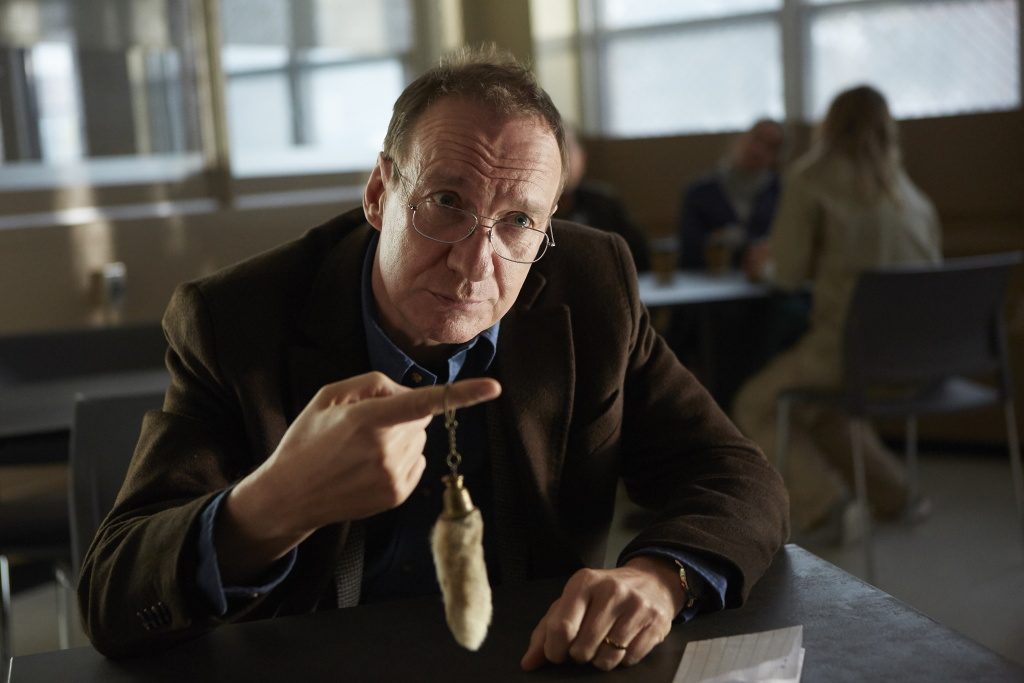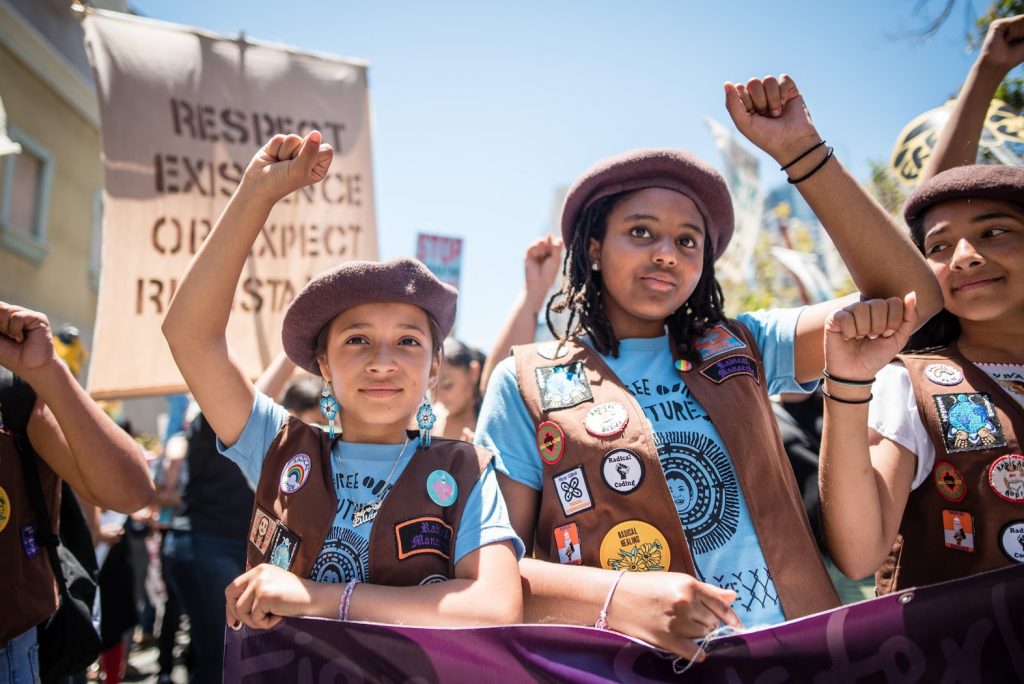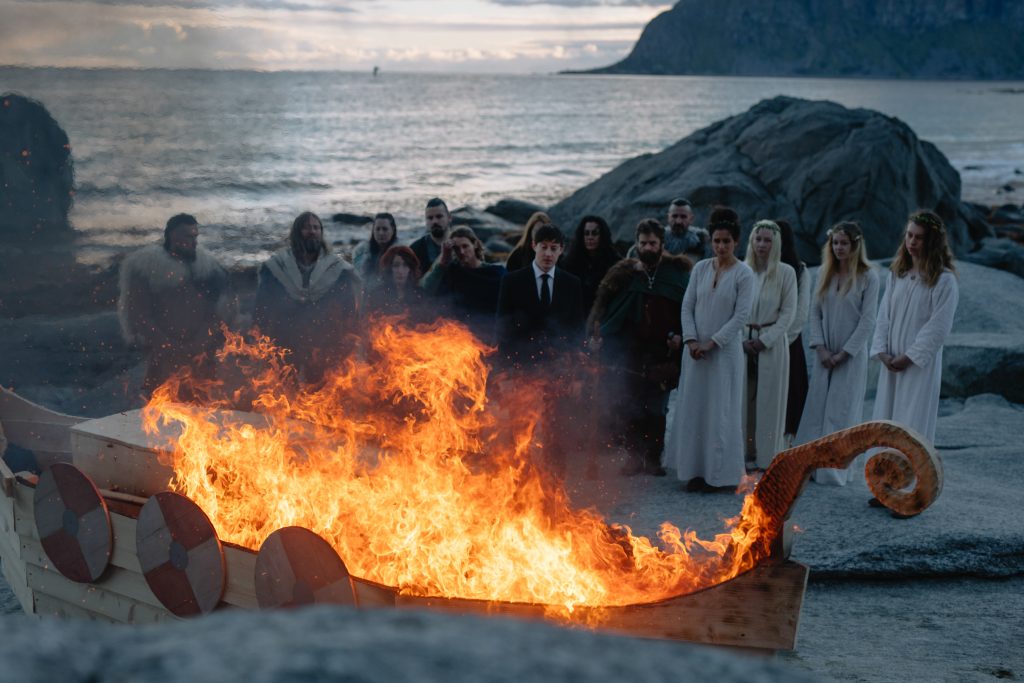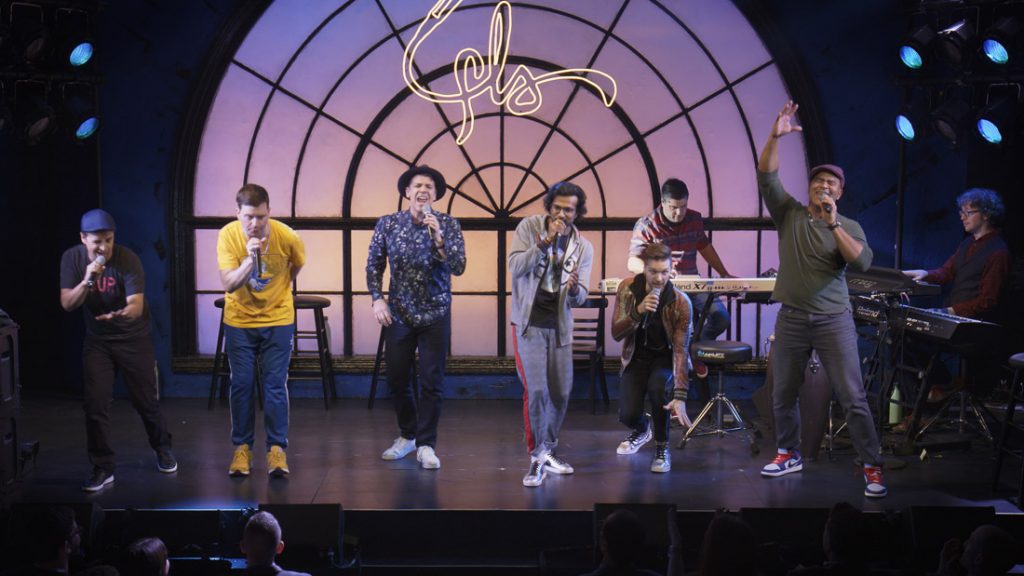July 22, 2020
by Carla Hay

Directed by Onur Tukel
Culture Representation: Taking place in New York City, the comedy “Black Magic for White Boys” has a predominantly white cast (with some black people) representing the middle-class.
Culture Clash: Various white men in the story use a magician’s spell to make certain people disappear or make their wishes come true.
Culture Audience: “Black Magic for White Boys” will appeal primarily to people who like quirky indie comedies that tend to be rambling and unfocused.

Writer/director Onur Tukel’s comedy “Black Magic for White Boys” premiered at the 2017 Tribeca Film Festival in New York City as part of the “Tribeca TV — Pilot Season” program for pilot episodes looking to get picked up for a full TV series. It doesn’t look like “Black Magic for White Boys” is going to be a TV series, so the six planned episodes have been condensed and released as a feature film instead. This movie format is a better fit for “Black Magic for White Boys,” which has a concept (white men trying to hold on to power in a politically correct world) that wears thin by the end of the film. There are also several annoying characters that viewers would not want to see again in a continuing series.
The story takes place in New York City, where a small, run-down performing-arts theater (which is not named in the movie) is the catalyst for most of the action in the movie. The theater, which has a seating capacity of about 50 to 60 people, is owned by a French immigrant couple named Larry (played by Ronald Guttman) and Magdalena (played by Lisa Azuelos), who frequently quarrel with each other.
Larry does a stage show as a magician (using the name Larry the Magnificent) in the theater, whose sparse attendance has put the theater on the brink of going out of business. However, one of the things that Larry is most proud of is that he has a book of magical spells that he has written himself.
Three of the theater employees work as assistants in Fred’s magic act: Lucy (played by Eva Dorrepaal), who is generally friendly to everyone; Dean (played by Colin Buckingham), who is self-conscious about being a little person; and recently hired Leah (played by Leah Shore), a mild-mannered naïf who looks and dresses like Barbra Streisand, circa 1976.
Another employee at the theater is theater manager Quentin (played by Brian W. Smith), who keeps warning Fred that the theater will have to shut down unless they can increase the number of paying customers. Magdalena is very aware that she and Larry are in dire financial straits. Magdalena wants to cut their losses and move back to France. Larry hates the idea and refuses to go out of business.
During this period of financial turmoil for the theater, two couples attend a Larry the Magnificent show on a fateful evening. One couple consists of businessman Jamie (played by Jamie Block) and his wife Wendy (played by Annie McCain Engman). They are on a double date with scruffy gadfly Oscar Trout (played Onur Tukel) and a much-younger woman named Chase (played by Charlie LaRose), who have met each other for the first time this evening because it was a blind date set up by their mutual friends Jamie and Wendy.
While the two couples are watching Larry the Magnificent’s poorly attended performance (the theater is less than half full), Larry picks Jamie out of the audience to participate in the disappearing act part of the show, when an audience member is placed in a box. The secret of this trick is that the box leads to a hidden walkway, where the person leaves the stage without being seen by the audience, and then magically “reappears” somewhere else in the theater.
To Larry and Jamie’s shock, the disappearing act actually works without the trick of using the walkway. When Jamie comes back, he has no memory of what happened when he disappeared, but he’s so impressed, that he stays after the show and tries to meet Larry the Magnificent to find out the secret of how he disappeared. Lucy tells Jamie that Larry isn’t available, but Jamie is determined to come back later to find out the secret.
Not long after that show, Larry and Magdalena are having another one of their arguments. She threatens to leave him. Larry knows that his magical spells seem to be working, so he makes Magdalena disappear. Larry seems surprised but not upset by her disappearance. Larry privately makes an attempt to find Magdalena, but when she’s nowhere to be found (and he genuinely has no idea where she is), he tells the rest of the staff that Magdalena has decided to leave and go back to France.
In the beginning of the movie, there’s some background on Jamie, who is shown to be a ruthless businessman. He owns an apartment building in a low-income neighborhood. And he’s personally and gleefully gone to the building to tell the tenants that their rent will increase 30% by the next month because of a new city law that allows it.
The tenants are understandably upset, and most say that they’re going to refuse to pay the rent increase since they can’t afford the new rent fee. There are various scenes in the movie that show the tenants (who are all people of color—mostly African Americans and some Latinos) griping about the rent increase in places like street corners while waiting for a bus or in a tenant meeting inside one of the building’s apartments.
Meanwhile, the movie shows that after the date at the magic show, Chase went home with Oscar and spent the night with him. Before they have sex, Oscar tells Chase some more about his background. Oscar, who has never been married and doesn’t have kids, is unemployed, but he brags that it’s because he’s been living off of an inheritance that his late father left him. Apparently, Oscar’s mother is also dead, and he has no siblings, because it seems as if Oscar got the entire inheritance.
Oscar is adamant in telling Chase that he never wants the responsibility of having kids, although he says that he’s open to finding a life partner. Chase tells Oscar that it’s not a problem for her that he doesn’t want kids, because she knows she has fertility issues and can’t get pregnant anyway.
It’s at this point in the story that you know exactly what’s going to happen—and it does: Chase gets pregnant, Oscar is the father, and Chase wants to keep the child. She finds out she’s pregnant four months after she and Oscar have been dating each other. When she tells Oscar, he’s furious about it.
First, Oscar tries to convince Chase to have an abortion. When that doesn’t work, Oscar attempts to trick Chase into taking an abortion pill that he buys from a drug-dealer friend named Fred (played by Franck Raharinosy), who carries around a pharmaceutical box filled with illegal and legal drugs. That doesn’t work either.
And then, Oscar remembers that Jamie told him that Larry the Magnificent’s magical spell really made Jamie disappear. And somehow, Fred has gotten ahold of Larry’s book of magic spells and passed on some of its secrets to Jamie, who has been using magic spells to make his complaining tenants disappear. When Oscar hears that there’s a magic spell to make people disappear, he thinks it would be a great idea to use this spell to get rid of Chase’s pregnancy by having the impregnated embryo disappear.
There’s also a subplot about magician’s assistant Leah, who’s been dating a racist and sexist moron named Ralphie (played by Brendan Miller), who degrades her and everyone who has the misfortune of being in contact with him. Leah breaks up with Ralphie and starts having a chaste romance with her co-worker Dean.
Ralphie, who sees himself as a desirable hunk, can’t believe that Leah has moved on by dating a little person. Ralphie begins to stalk Leah at the theater and tries to sweet-talk his way back into Leah’s life. Ralphie says he’s now in therapy and taking medication for his emotional problems, so Leah dumps Dean and gets back together with Ralphie. Guess where Ralphie got the medication? Fred, of course.
Dean is crushed by the breakup and feels that he was jilted because of his below-average stature. Leah insists that wasn’t the reason why she ended their romance, but Dean decides that he’s tired of being short. And who comes to the “rescue” again? It’s Fred, who gives Dean a pill and magical spell that Dean can use to change his physical appearance to be a better-looking, taller version of himself.
And the story takes another bizarre turn when Larry orders theater manager Quentin to get the menstrual blood of a young virgin. (The reasons why are explained in the movie.) Quentin thinks the fastest way to find a female virgin is to interview barely legal women to work at the theater. In one such interview, after getting some basic questions out of the way, Quentin awkwardly asks the young woman if she’s a virgin. You can imagine what her reaction is, especially in this #MeToo era.
Meanwhile, Oscar’s problems escalate when he finds out that his accountant/business manager (played by Kevin Corrigan) swindled Oscar out of all of his inheritance money by making bad investments without Oscar’s permission. Oscar is then forced to find a job. During a job interview that Oscar has at a computer company, where he’s being interviewed by a man who’s about 20 years younger than Oscar, this insufferable blowhard shows how old and out of touch he is by talking about his skills with outdated software.
Oscar then goes on a rant about race where he tells the white man interviewing him that white men are under siege and need to stick together. Oscar also goes off on a tangent about how he’s really of Middle Eastern heritage, and he can pass as white or a person of color, depending on whatever situation suits him best. In what’s supposed to be a joke, Oscar then says if the company needs to fill a quota to add a Middle Eastern or Latino staffer, he can be that person.
What is the point of “Black Magic for White Boys”? It’s basically Tukel’s sloppily written social commentary on how white men feel their power slipping away in a country (the United States) where women and girls are 51% of the population, there’s an increasing number of non-white people, and there are more demands for positions of power to have a more accurate reflection of the racial and gender diversity that exists in the U.S.
All the white men in this movie take some kind of action to try to make themselves feel like they are asserting their power. Larry makes his wife Magdalena (portrayed as a nagging shrew) disappear. Jamie knows that his tenants are organizing meetings to fight back against his outrageous rent increase, so he makes these tenants disappear.
Oscar thinks that if Chase gives birth to their child, she’ll be trapping him into paying child support for the next 18 years. And so, Oscar tries to make the pregnancy disappear. How this pregnancy issue is ultimately resolved seems like the movie’s weak attempt to prevent any criticism that the movie is too offensive when it comes to unplanned pregnancies.
Ralphie pretends that he’s changed for the better, in order to get back together with Leah in a relationship where he’s the dominant partner. (And the movie plays into stereotypes that women prefer “bad boys” over “nice guys.”) And even “nice guy” Dean aspires to society’s physical ideal of what it means to be a man, because Dean wants to have more power when it comes to dating women.
Fred exerts his power by being the story’s Dr. Feelgood, who gives the image that he has the answers to people’s problems in his pharmaceutical box. Fred, a white drug dealer, has a somewhat “respectable” image in this movie, compared to how a black drug dealer doing the same things would be portrayed as a “criminal who should be locked up” in this movie or other movies like it. At any rate, all the non-white people in the movie are portrayed as subservient in some way to white people.
“Black Magic for White Boys” tries to be funny, but most of the jokes don’t really land very well. Any of the dialogue that’s deliberately politically incorrect just seems too self-aware to be genuinely funny. The acting in this film is adequate. It’s the writing that really makes this film an often-boring mess.
And writer/director Tukel shows his Generation X age in some of the jokes. For example, one of the African American men in the movie resists Jamie’s attempts to buy his house. He says to Jamie, “The last time I let a white man in my house, he tried to play Air Supply on my stereo.” Most people born in or after the 1980s won’t understand that joke, because they won’t even know who Air Supply is.
Another ’80s reference in one of the movie’s jokes is made when someone shows a picture of the Elephant Man, and the other person asks if that’s a picture of actor Mickey Rourke. It’s a joke that works best for people who know the context of how Rourke was a handsome sex symbol in the 1980s. Comparing the Elephant Man to what Rourke looks like now is kind of an insider-ish cheap shot that will go over the heads of people who don’t really know movie history or don’t even know who Rourke is.
Another example of how the movie isn’t written very well is how it handles a “dress code” issue for Oscar, who prides himself on being a non-conformist. Oscar gets a phone call telling him that he got the job that he interviewed for at the computer company. But to his dismay, the person who calls Oscar with this news also tells Oscar that his long-ish hair and bushy beard will be a problem for the company, so Oscar agrees to cut his hair and shave his beard in order to get the job.
And yet, later in the story, when he starts working at this company, Oscar’s hair and beard remain unchanged. It just doesn’t make sense to make such a big deal about him having to cut his hair and beard (presumably as an example of how Oscar has to change in order to fit in as another office wonk) and then abandon that idea altogether. It’s an example of this movie’s sloppy screenwriting and careless directing.
In the end, the issue over Oscar’s hair and beard was unnecessary because Oscar makes some other decisions in his life which contradict the type of person he obviously was proud of being for several years. This drastic personality change for Oscar looks like Tukel’s insipid attempt to placate any viewers of this movie who would object to Oscar’s plan to terminate Chase’s pregnancy.
And it’s one of the wishy-washy things about this movie, which can’t decide if it wants to be a dark satire or a series of absurdist comedy sketches strung together. (Within the movie, there are five different chapters that are labeled.) If you’re going to have a character such as Oscar, who’s a politically incorrect lout, then go all in, and stick with it. The world is filled with too many comedies that are ruined by taking the easy way out and having a longtime jerk suddenly turn into a big-hearted softie.
Oscar’s storyline is wrapped up nicely with a tidy little bow, but almost all of the other characters’ story arcs wander and aren’t necessarily resolved at the end of the film. Maybe that’s because this movie was originally conceived as the first season of a series. But even then, there’s not really much of a story left at the end for anyone to be interested in seeing what would happen next.
MPI Media released “Black Magic for White Boys” on digital and VOD July 3, 2020.


















